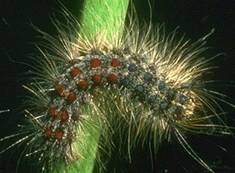Gypsy
Moth:
California's Next Pesticide Emergency?
NEWS:
Ceremony
and Peaceful Declaration Against the Gypsy Moth Spraying in the Ojai Valley:
Friday
April 24th, 2009
8:30
a.m.
Lynda's Home
806 S. La Luna, Meiners Oaks, California
Please see the video about what happened last time
the Department of Agriculture "visited"
Lynda Rader's home, and violated her safety and civil rights by
forcibly exposing her and others to pesticides.
CDFA ASSAULT ON OJAI VALLEY
MARCH/APRIL 2009
On
Saturday March 28, 2009, thugs from the California Department of Food
and Agriculture showed up at the doors of residents in the Ojai Valley,
with a sheriff and court order, frightened
and intimidated elders,
jumped locked fences, and forcibly sprayed people's homes with the
insecticide Bacillus thuringiensis var. kurstaki (Btk) without warning.
Residents
had been led to believe that they could refuse to have their properties
sprayed,
or that they could cover plants not susceptible to gypsy moths, and
were advised to bring their pets inside during the spraying. They were
not given adequate notice to do any of this, nor to make arrangements
to be elsewhere themselves. Several residents had already been sickened
by the previous round of spraying. Applications are being made every
two weeks, over the course of several days, with drift between
neighborhoods allowing for no relief.
|
On
September 2, 2008 a
Finding of Emergency
was filed with the Secretary of State, establishing Alameda County as
an eradication area for gypsy moths, effective immediately.
Alameda
joins eleven other California counties already established as gypsy
moth
eradication areas under such findings of "emergency": Los Angeles,
Marin, Nevada, Orange, Riverside, San Diego, San Mateo, Santa Barbara,
Santa Clara, Santa Cruz, and Ventura counties.
This regulation
gives the State the "authority to perfom detection, control and
eradication activities against gypsy moth" in these counties.
A
gypsy moth egg mass was found on a boat
in Oakland August 20,
but the
gypsy moth that triggered the "finding of emergency" was trapped the
next day, on August 21, in one of the little green traps you see all
over California.
Each trap contains a lure that emits chemical fumes into our
environment. They
often hang low on tree trunks, and in easy reach of small children, as
can be seen in these photos. One of these traps had been ripped open,
likely by one of the many curious children who congregate near where it
was found. The black line in the top third of the broken trap is the
lure, similar to the pesticide twist ties used in the light brown apple moth (LBAM)
program. One of the chemicals
it contains is disparlure, a synthetic "pheromone", classified as a
pesticide when used with the intention of eradicating, but
because of a bureaucratic loophole not classified as a pesticide when
used to monitor
or detect, even though the same chemical is used. The toxicity of
disparlure has not been well studied, but it has been found to
persist in the body for decades.
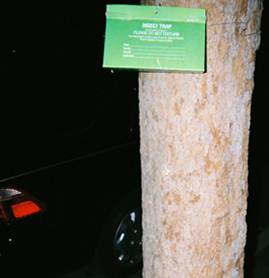
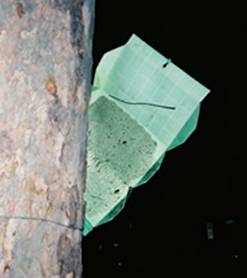
California
Department of Food and Agriculture Gypsy Moth webpage
California
Gypsy Moth Regulations - Current Quarantines and Eradication Areas
Environmental
Assessment for Gypsy Moth program in Ojai Area in March 2009
SPRAYING TO BEGIN IN OJAI MARCH
9, 2009
Nonviolent Civil
Disobedience Training
in Response to Gypsy Moth
Pesticide Program
Sunday,
March 8, 2009
- 2-6pm
followed by potluck
1273 South Rice Road,
Ojai, CA 93023
(10th house on right by community pool)
(Please park on street outside of mobile home park - not inside)
For more info call (805)
794-1856
(Sponsored by Pesticide Free Ojai Valley, with support from Don't Spray
California)
GYPSY MOTH PROGRAMS
THROUGHOUT THE U.S.
Other
states already have extensive pesticide programs, especially in the
northeast,
where entire states are under quarantine (as of September 25, 2008:
Connecticut,
Delaware,
District of Columbia, Maryland,
Massachusetts,
Michigan,
New Hampshire, New
Jersey, New York, Pennsylvania,
Rhode
Island, and
Vermont) and many others are under partial quarantines (Indiana,
Illinois,
Maine, North
Carolina, Ohio,
Virginia,
and Wisconsin).
Many, but not all states with quarantines have gypsy moth programs in
place. Sometimes it is left up to the counties to implement programs
themselves, or residents are encouraged to hire pesticide applicators.
Most Recently Updated
Federal Gypsy Moth Quarantines
The most wide-spread gypsy
moth pesticide program is the "Slow
The Spread (STS)" program, an active partnership between the
USDA (Forest
Service and Animal and Plant Health Inspection Service (APHIS)),
the Department of Interior National Park Service, and several other
State and university programs. The states involved in the STS
program are
Illinois, Indiana, Kentucky, Michigan, Minnesota,
North Carolina, Ohio,
Virginia, West
Virginia, and Wisconsin. Notice
that not all of the
quarantined areas are part of this program, nor are all states that are
participating in it under quarantine.
"Slow the
Spread" Pesticide Application Maps and Details
There
are other states, which neither have quarantines, nor are part of
the STS program, which have gypsy moth pesticide programs, or have left
it up to local municipalities to
implement them on their own. Trapping for the gypsy moths is done in
most, if not all, states.
Annual
Trapping Surveys Throughout the U.S.
Washington
State has an active gypsy moth program, and applied pesticides in
various areas for several years. Currently there are no official
applications planned for 2009, nor were there in 2008, though extensive
trapping, especially heavily in the areas where moths were found,
continues. Oregon
also has an active gypsy moth program, with pesticide applications made
as recently as Spring
2008, and more planned for 2009
in Eugene.
PESTICIDES USED IN GYPSY MOTH
PROGRAMS
Common
pesticide products used in gypsy moth programs are Bacillus
thuringiensis kurstaki (Btk) (Foray), disparlure (Disrupt),
diflubenzuron (Dimilin),
tebufenozide (Mimic, Confirm), Nucleopolyhedrosis
virus (NPV) (Gypchek). Nurseries may use diflubenzuron, chlorpyrifos,
carbaryl, acephate,
cyfluthrin, phosmet, and spinosad.
Gypsy
Moth Management - What is being done to control the gypsy moth?
USDA
Approved Regulatory Treatments for Gypsy Moth for Nursery Use Only -
2008
The
chemical industry has been selling Bacillus thuringiensis
(Bt) and
so-called "pheromones" as natural alternatives to pesticides,
even though they all contain synthetics chemicals. The U.S. Department
of
Agriculture's National
Organics Program, and the Organic
Materials Review Institute, participating in the greenwash,
allow both Bt and synthetic "pheromones" for use in organic
agriculture, further diluting organic
standards. If you google "non-chemical" options for gypsy moth control,
the
results are dominated by entries about Bt, even though every Bt product
on the market contains synthetic chemicals, so-called "inert"
ingredients, which are kept undisclosed,
protected as "proprietary" by trade secret laws, are frequently even
more toxic than the "active" ingredients listed on the label, and are
specifically designed to interact synergistically to achieve greater
toxicity than each chemical by itself.
Unidentified
Inert Ingredients in Pesticides: Implications for Human and
Environmental Health Cox and Surgan (pdf)
Chemically Induced Diseases:
Synergistic Effects and Cumulative
Injuries caused by Toxic Chemicals Alexander
The
Impacts of Chemical Mixtures - Our Stolen Future
Synergism by Ingrid Pollyak
While
government agencies and pesticide manufacturers downplay the importance
of synergism, this essay, by a teen who homeschools, illustrates that
understanding synergistic effects of chemicals does not require a Ph.D.
The
dangers of chemical exposure are commonly downplayed with statements
that the quantities of their poison are miniscule, with pesticide
manufacturers and legislators going to great lengths to agree on just
how much poison is legally acceptable to let loose on our environment.
But in addition
to synergistic and cumulative effects of chemical mixtures, some
chemicals have a "nonmonotonic" dose-response, where reducing the dose
of the chemical does not result in a reduction, but an increase in
toxic effects.
The
Low Down on Low-Dose Endocrine Disruptors
While
undisclosed ingredients and chemical mixtures are serious, and often
ignored issues, the recent focus on secret toxic "inerts" has
mistakenly taken the focus off these "active" ingredients sold as
"organic", "natural", and
"biological". But Bt and disparlure have their own toxicity and
unknowns:
Bacillus thuringiensis kurstaki
(Btk)
Bacillus
thuringiensis var. kurstaki, a bacteria mixed with secret "inert"
chemical
ingredients, has been sprayed both by air and by hand as part of gypsy
moth programs. It is sprayed by air in many states, including Oregon
and Washington, and was recently sprayed manually in Los Angeles County
in 2008, and is planned for the Ojai area in Ventura County in March
2009.
Btk
is implicated in gastro-intestinal illness and damage to the immune
system. It has
sickened thousands of people
in New Zealand, prompting resistance which led to a People's Inquiry
when their government was unresponsive.
Toxicological
Profile for Bt by Northwest Coalition for
Alternatives to Pesticides
(NCAP) (pdf)
Toxicological
Profile for Btk
by Northwest Coalition for Alternatives to Pesticides
(NCAP)
(pdf)
No
Spray Zone Overview of Btk (pdf)
(Unfortunately until
recently No
Spray Zone supported the use of disparlure
as a "natural" alternative to Btk, and their webpage on the subject
remains somewhat contradictory, and the NCAP tox profile for Btk
takes a somewhat neutral position on synthetic "pheromones".)
In Ojai,
the Btk product
being sprayed
from high pressure hoses is called DiPel
Pro DF, it contains Bacillus thuringiensis var. kurstaki (Btk), in a
46% mix of undisclosed, proprietary chemicals. Pesticide information
from the manufacturer, which is obviously not as
reliable information as independent
science, downplays the risk of harm of
their product. But even their Material Safety Data Sheet, label, and
Organic Certificate from the Organic Materials Review Institute, don't
deny that there are serious risks:
According
to the manufacturer's MSDS: "MEDICAL CONDITION AGGRAVATED BY
EXPOSURE: Impaired respiratory function."
DiPel
Pro DF Material Safety Data Sheet (MSDS)
In 2005,
the U.S.
Surgeon General reported that in the U.S. 1 in every 8
children has asthma, and the number of asthma sufferers had tripled to
20 million over the 25 years prior, that every day 12 people die and
5,000 emergency room visits are due to asthma. In 2007 a California
Health Interview Survey estimated that as much as 13.6%
of the Ventura County population was at some time diagnosed
with asthma.
Asthma is
just one of many conditions that impair respiratory function.
According
to the label's First Aid instructions, on inhalation of the
product, "if person is not breathing",
call an ambulance and "give artificial
respiration", and skin contact requires rinsing
"immediately with plenty of water for 15-20 minutes".
DiPel
Pro DF Label
The
label clearly states:
"Do not apply
this
product in a way that will contact workers or other
persons, either directly or through drift."
Disparlure (Gypsy Moth
"Pheromone" - Mating Disruption)
Disparlure,
the synthetic "version" of the gypsy moth pheromone used in "mating
disruption", which
is in the traps you see around town, and which is sprayed aerially as
part of the STS program in many states, has been shown to persist in
the human body for decades, as is outlined in these documents by
scientist E. Alan Cameron, who, after he stopped working with this
chemical, has continued
to attract moths for many years:
Disparlure
Persistence After 2 Years
Disparlure
Persistence After 4 Years
Disparlure
Persistence After 17 Years
Even the
risk assessment of disparlure by the USDA Forest Service admits
that the chemical may persist in a person's body for years after
exposure. It also admits that there are "limitations in the
availability of
toxicity data on
disparlure", that there have been no studies on the
effects of disparlure on the immune,
reproductive, endocrine, or nervous systems, nor whether it is
carcinogenic.
In an
outrageous display of
arrogance in the light of such complete lack of safety data, the only
"sensitive subgroup" of people at "special risk" that
the Forest
Service can imagine, might be "individuals who have an aversion to
insects" because "individuals who are exposed to sufficient quantitites
of
disparlure and who live in an area in which gypsy moths reside will
attract the moth."
Continuing
the disinformation, the agency claims that "insect pheromones are
generally regarded as nontoxic to mammals", but fails to
clarify that the "pheromone" product they are using is a
synthetic
chemical designed to mimic a pheromone, and is, in fact, not an
actual insect pheromone at all.
When
it comes right down to it however, the Forest Service has to admit that
disparlure is not nontoxic, that some toxicity has in fact
been
established ("acute exposure to disparlure has very low toxicity in
mammals"). "Very low" is of course not a meaningful measurement,
especially in regard to a chemical about which virtually nothing is
known, and residents in sprayed areas are not acutely, but chronically
exposed.
USDA
Forest Service Disparlure Risk Assessment
"Pheromone" products
are specifically designed to release
their chemicals slowly over time, which ensures that the
chemical saturates the environment, and exposure is constant,
not
for hours or days, but for weeks and months.
In the case of the light
brown apple moth program
the LBAM "pheromone" was in time released capsules. This brought with
it
an unexpected consequence for people
who attempted to do clean up after the spraying: when people hosed
down their yards, sidewalks, and cars, the water appeared to reactivate
the mixture and people were exposed to an even stronger dose than they
were from the dry capsules.
The
disparlure product the USDA Forest Service uses in aerial applications
is Disrupt II, manufactured by Hercon.
Disrupt
II Label (pdf)
Disrupt
II Material Safety Data Sheet (pdf)
The chemical mixture
is embedded
in polyvinyl
chloride (PVC, vinyl) flakes, which is also not non-toxic,
not in its
manufacture,
nor disposal, and not when ignited. In a list
of accidental fires involving PVC,
Greenpeace finds that it contributed to the start and/or spread of each
fire, and "emitted life-threatening gases and chemicals":
"Besides
the acidic hydrogen chloride, a wide variety of chlorinated and
non-chlorinated organic chemicals evolve from PVC during high
temperature pyrolysis and combustion: benzene, toluene, formaldehyde,
chloroform, chlorinated biphenyls, dioxins and dibenzofurans, and many
others. The emission during fires of benzene, chlorinated dioxins, and
dibenzofurans - known carcinogens - appears to explain the high
frenquencies of leukemia, laryngeal and colon cancer, and of the rare
soft tissue cancers found in many firefighters at relatively young
ages."
PVC flakes
spread everywhere promise to cause toxic fumes
during possible fires, be they wildfires, house fires, or
campfires in
the near future. Even the manufacturer's MSDS admits that when Disrupt
flakes are
burned "the hazardous decomposition products that will result because
of incomplete combustion include carbon monoxide, other unidentified
products of hydrocarbon degradation, Nox, low
level cyanides
and
hydrogen chloride".
Hercon claims that
the plasticizer used in this product is biodegradable, but no other
details are
disclosed. The most common PVC plasticizers are
phthalates, which can be classified as biodegradable, but
which have been linked to endocrine
disruption and are possible
carcinogens.
Disrupt II is used
with a sticker agent, an adhesive, so that
flakes can stick to foliage. STS
uses Gelva Multipolymer Emulsion 2333. In a technical
document about gypsy moth mating disruption the Forest
Service makes
public the Material Safety Data Sheet of the adhesive:
Gelva
Multipolymer
Emulsion 2333 MSDS (pdf)
The
MSDS reveals that it contains vinyl acetate, a suspected carcinogen.
Vinyl
Acetate Chemical Profile on Scorecard
The rest of the
ingredients are vaguely named acrylic copolymer, and it
is noted
that the "specific chemical identity (including CAS No.) and/or
concentration is being withheld because it is trade secret".
The
chemicals in this mix may be doing their own damage to the tree
canopy. During an evaluation
of efficacy of different "pheromone" products, it was found
that "either the sticker or pheromone from the flake appeared to have
localized impact on leaf tissue as necrosis was observed at and
immediately surrounding the contact point".
In addition to
disparlure, some of the gypsy moth traps used by the Forest Service,
the ones that look like milk cartons, also contain Vaportape strips,
which contain
dichlorvos (DDVP), an organophosphate which causes cancer, is a
mutagen, and
interferes with prenatal brain development. The name of the product
itself implies that there are vapors, that volatilization, in other
words chemical drift, is expected.
Toxicological
Profile of Dichlorvos
Toxicological
Description of
Dichlorvos (in a toxicological profile of naled) (pdf)
Vaportape
GM Insecticidal Strips Label (pdf)
Diflubenzuron &
Tebufenozide (Insect Growth Regulators)
Nucleopolyhedrosis
Virus
(NPV)
And
the greenwashing continues with the "natural" product Gypchek, made
from nucleopolyhedrosis virus (NVP),
which appears to be specific to the gypsy moth. It is another sprayed
pesticide product, and a perfect example of the hypocrisy of the
pesticide industry: We're supposed to be concerned about caterpillars
causing allergies with their hair, and a stinky nuisance with their
poop, so they
grind up the allergenic caterpillars, infected with the virus, mix
them together with other chemicals, about which little is known, and
spray it into our enviroment.
How
Gypchek is Made
According to USDA
Forest Service Risk Assessment for Gypchek
"Gypchek
does contain substantial
amounts (>80%
by weight) of gypsy moth larvae
parts, including hairs which are known to cause skin and respiratory
irritation
in humans.
Based on the available animal data, there is clear evidence that
Gypchek can
cause eye irritation."
"Also
as with most pesticides, the
toxicity data base on Gypchek is extremely limited for certain types of
biological effects for which the U.S. EPA does not routinely require
testing –
i.e., immunotoxicity,
endocrine effects, and neurotoxicity."
Gypchek
Label
Gypchek
MSDS
Gypchek is mixed either with a surfactant, Carrier 038A (Abbott
Laboratories), or with Lignosite
AN (Georgia Pacific) and an adhesive, Bond (Loveland Industries), in
molasses.
The risk assessment of the Forest Service continues to describe what is
not known:
Gypchek
is typically applied with a
carrier, either Carrier 038A or a lignosulfonate-molasses carrier and
another product, Blankophor, may also be included in Gypchek
applications. Toxicity
data on these adjuvants are extremely limited. Carrier 038A is a
proprietary
surfactant formulation.
Surfactants are soap-like materials that can have a spectrum of toxic
effects,
most of which
involve irritation to biological membranes. This appears to be the case
for
Carrier 038A.
Toxicity data on this material is scant."
Carrier
038 MSDS
About Blankophor
BBH
(Burlington Chemical Co.), which is an
"optical
brightener", the Forest Service
assumes "very low toxicity" based on "limited toxicity data".
Organophosphates:
Several
organophosphates are used in nurseries against gypsy moths,
chlorpyrifos, acephate, and phosmet.
Chemicals in this class of chemicals are associated with serious health
damage, including to the immune, reproductive, and nervous systems, as
well as cancer.
Rachel Carson Council on
Organophosphates
Chlorpyrifos
Chlorpyrifos
is a
broad
spectrum organophosphate insecticide that damages the immune and
central nervous systems, is associated with birth defects, and genetic
damage. It contains other hazardous "inerts". One commonly found is
xylene, which can cause hearing and memory loss, and leukemia.
Chlorpyrifos is also toxic to beneficial insects, such as bees,
ladybugs, and parasitic wasps, as well as fish, a wide variety of other
aquatic organisms, and birds. Cats and other mammals have been
poisoned, and even plants have been damaged by it. Chlorpyrifos is
manufactured by Dow
AgroSciences
Toxicological
Profile of Chlorpyrifos (pdf) by Northwest Coalition for
Alternatives to Pesticides (NCAP)
Chlorpyrifos
Fact Sheet (pdf) by Chemical Watch and Beyond
Pesticides
Farmworkers
sue over Chlorpyrifos danger San Jose, July 2007
"Farm
workers and advocate groups today filed a lawsuit in federal
district court today against the Environmental Protection Agency to
stop the continued use of a deadly pesticide called chlorpyrifos.
Chlorpyrifos is a highly neurotoxic insecticide developed from World
War II-era nerve gas. Exposure can cause dizziness, vomiting,
convulsions, numbness in the limbs, loss of intellectual functioning,
and death."
Acephate
Phosmet
Phosmet is another
organophosphate which produces injuries typical of
that class of chemicals, including being a possible carcinogen, and
is implicated in damage to the central nervous system.
Toxicological Profile for
Phosmet
Phosmet has also been
suggested as a possible cause of
Mad Cow Disease,
as the onset in the U.K. coincided with ranchers being
required to use
phosmet on their cows, and the conventional explanation of the feed
being the cause is not sufficient to explain the cases of Mad Cow in
cows not fed the questionable feed.
Mark
Purdey's Research into Phosmet as Causative Agent in Mad Cow Disease
Cyfluthrin
Cyfluthrin is a
synthetic pyrethroid, which is neurotoxic, linked to
cancer, and reproductive harm.
Toxicological
Profile for Cyfluthrin
by Northwest Coalition for Alternatives to Pesticides
(NCAP)
(pdf)
Carbaryl
Carbaryl
is a carbamate, which is a carcinogen, mutagen, a
hormone disruptor, does
reproductive harm, and adversely impacts the immune system.
Toxicological Profile for Carbaryl
by
Northwest Coalition for Alternatives to Pesticides
(NCAP)
(pdf)
Spinosad
Spinosad
is another pesticide that is "approved" for
organics, representing further dilution of organics standards. It is
considered non-synthetic, but also contains undisclosed synthetic
"inerts".
Spinosad is implicated in the killing of non-target species, including
honeybees. The
Organic Materials Review Institute (OMRI) states that
"Spinosad, while an improvement over some materials, is still fairly
broad spectrum and not representative of an ecological approach."
Spinosad is manufactured by Dow.
Review of
Spinosad by Organic Materials Review Institute (pdf)
"These
review comments should not be taken to be an
evaluation of the
patented formulation of Spinosad containing inert compounds."
WHY IS THIS
HAPPENING?
In
the Northeastern U.S. gypsy moth pesticide programs are no longer
"eradication" programs, but "slow the spread"
programs. The USDA and other agencies involved admit that they can
never get
rid of the gypsy moth, but are merely delaying the inevitable. The
clear
implication is that there is no end in sight for these ongoing chemical
assaults on people and wildlife. Instead of addressing the problem at
the root,
and figuring out how we might learn to live with this moth that is here
to stay,
they've firmly placed both feet on a toxic treadmill.
So what are
the real issues with the gypsy moth?
The
Indiana Department of Natural Resources gives several justifications
for their pesticide program in their public relations power
point presentation, with a dramatic slide
show of hairy caterpillars and spongy egg masses:
* The
caterpillars
make a mess and smell bad.
The
pesticides smell bad too, and are toxic. The USDA, which is
funding the gypsy moth "Slow the Spread" program, also subsidizes Factory-scale
dairy farms, which make a much greater stink, and cause
illness.
*
Caterpillar hair is an
allergen.
When
people complain about being poisoned by pesticides, they are often told
that they are merely "allergic" to something in the pesticide. Agencies
often find themselves compelled to preempt complaints in their "risk
assessments", by admitting that some people may react to the pesticide,
and claiming that those people are inherently unusually "sensitive",
not sensitized by pesticide exposures. Many things
cause allergies
in people, but the government isn't shooting puppies on sight,
or
shutting down the peanut or soy industries.
* Trees
are destroyed by defoliation.
Ironically
one of the pesticides used in the gypsy moth program, the "pheromone"
flakes, have been shown to cause necrosis
of leaf tissue
on contact. And the vast logging, which the Forest Service and other
agencies are involved in, has done a great deal more defoliation than
any moth ever will. In fact, in Pennsylvania the
gypsy moth is being used as an excuse to log forests for profit:
Appeal
planned over Governor Dick logging - Environmentalists say cutting down
trees will put habitat in peril 11-30-08
Gypsy
Moth is not real reason for clearcuts, herbicides and log money 1-18-09
Earth First activist Asanté Riverwind
also questioned the motivations of the gypsy moth pesticide program by
the
Forest Service in Oregon and Washington State back in 2000: "In typical
paradox, the USFS continues to plan timber sales in old-growth stands,
while
pretending to be concerned about the loss of critical old-growth
habitat as a
pretext for spraying. Another reason the USFS gives for the spraying is
to
protect humans from being irritated by the stinging hairs of
TM caterpillars.
Apparently wood workers, and loggers in particular, develop increased
hypersensitivity
and allergic reactions to the caterpillars mildly stinging hairs."
Insect
infestations are a sign of imbalance, and most of these "pest"
problems were caused by the agriculture industry, land-grabbing
developers, and
complicit forest mis-managers themselves.
Even
conventional gardening
expert
Jeff Ball
agrees that "When gypsy moths attack your trees and shrubs in
sufficient number for you to begin to see damage, it is likely that the
plants were experiencing some degree of stress BEFORE the moths
appeared."
Sue
Seppi of
the Pennsylvania Group Against Smog and Pollution (GASP)
describes how
Entomophaga maimaiga, a fungus that had been introduced specifically to
control
the gypsy moth, but was believed not to have established in the
U.S., may
have in fact been quietly adapting in similar species that are
also
vulnerable to the pesticide applications. When fewer communities agreed
to
continue the ongoing pesticide programs, the fungus finally got a
chance to
thrive, and the gypsy moth caterpillars grew to half their usual size
and died.
She is one
of many who has described how "the gypsy moth population typically
peaks
and crashes, rising again over approximately a four year cycle. The
greater the
peak, the deeper the fall". Leellen Solter and Charles Helm of the
Center
for Economic Entomology and James Cavanaugh of the Illinois
Department of Agriculture
agree that "The gypsy moth is an 'outbreak species'; in infested areas
the populations build up over a period of years, peak in very high
densities, then decline strongly in the presence of natural enemies
such as parasites and diseases." The West
Virginia Division of Forestry finds that "In the northeastern
states, gypsy moth populations peak every 8 to 11 years."
And scientists
in Croatia studied
the predictability of population dynamics of the gypsy moth in
conjunction with
climate data there, finding that "Strong Gypsy moth outbreaks occur
regularly with a significant periodicity of 10.6 years. A peak in the
Gypsy
moth population density can be expected 5.2 years after the onset of
the
latency period, i.e., upon the ending of the previous gradation."
Asanté
Riverwind points again to those who "manage" nature as a "resource" for
profit, and suggests that it is in fact that "commodity-blinded mindset
which calls
natural cycles epidemics or catastrophic."
Rarely does
anyone praise a hairy, hungry
tussock moth, but a study has shown that gypsy moth outbreaks may
actually slow
the spread of Lyme disease, by way of chain
reaction typical of nature's food web: As defoliation reduces
acorn production, the white-footed
mouse population is also reduced, because acorns are
their primary food. Deer enjoy acorns as
well, and thereby
bring the ticks they carry to areas populated by the mice, which are a
primary transmitter of
Lyme disease.
Chain
Reactions Linking Acorns
to Gypsy Moth Outbreaks and Lyme Disease Risk
Asanté
Riverwind points out that tussock moths "have an ancient role in a
healthy
forest ecosystem", and that defoliation can be explained as
ecologically relevant
by a study by scientist Catherine Parks, which "revealed that during
drought periods when populations peak for the caterpillars of conifer
needle
eating species, the resulting defoliation helps trees to survive by
reducing
the amount of moisture lost through transpiration/evaporation. Instead
of
refoliating, the defoliated trees survive by using their energy to
build up starch
reserves in their roots. Of course, some trees die, providing nutrients
for the
soil, reducing competition for scarce moisture and creating homes for
woodpeckers and numerous other species."
Research
by the USDA's own scientists shows: Dead
& dying trees stabilize biodiversity, logging ends it!
And
the same is true for pesticide use, which eliminates biodiversity and
prevents natural, evolutionary processes to take place.
ALTERNATIVES
Non-chemical
alternatives exist. They always do. Strangely enough our
species
managed to survive for centuries without intervention with synthetic
chemicals.
Manual
controls
Manual
controls are simple: gypsy moths have one very predictable
lifecycle per
year.
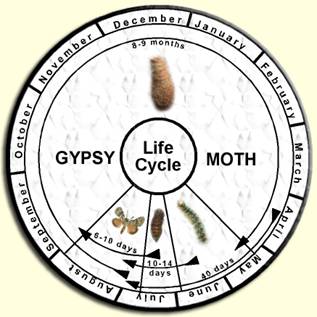
If
it's the European version of the moth, the female can't fly, so they're
easy to
catch. Pupae can be removed, and egg masses can be vacuumed or scraped
off, and
destroyed.
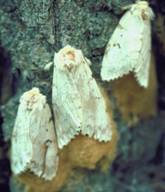

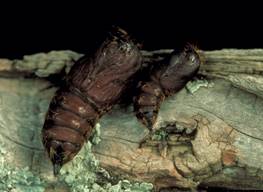
Caterpillars can be trapped on the way up the tree with plain,
untreated burlap
bands, then
picked by hand or vacuum.

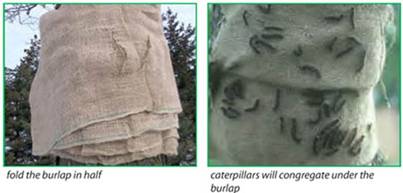
Burlap bands are a
type of trap, a non-chemical one. The traps the Ag
Departments and
Forest Service use emit chemical fumes constantly. They are designed to
saturate the environment for long periods of time with disparlure. Also
beware chemically treated burlap
bands. Some people treat the burlap with various chemicals,
particularly Eradicoat,
which is made with permethrin,
a neurotoxic, carcinogenic, endocrine disrupting, chromosome damaging
insecticide, that is especially deadly to cats.
This is one kind of
agricultural bug vacuum. Surely the USDA employs some scientist or
tinkerer who could design
one specifically for gypsy moths, their caterpillars and pupae, and out
of reach egg masses.


Prevention
& Longterm Ecological Balance
Planting and encouraging a
wide diversity of trees and other plants, over time will balance the
presence
of both gypsy moths and its predators. Mono-cultures in agriculture and
forests
leave plants vulnerable to insects, while diversity supports a
self-maintaining
ecosystem. Where human activities have done ecological damage, it's
only right
to take responsibility and put effort into repairing it.
There are many
lists
of plants that gypsy
moths prefer and others they avoid. For example, they
prefer oak, apple,
alder, aspen, basswood, birch, poplar, willow, hawthorn, hemlock,
tamarack
(larch), pine, spruce, witch hazel, linden, sweet gum trees, crabapple,
cherry,
beech, and hickory. They avoid ash, butternut,
black walnut, sycamore, ferns, redbud, rhododendron, American holly,
azaleas,
bald cypress, locust, catalpa, dogwood, easter red cedar, elderberry,
balsam
fir, grape, horse chestnut, juniper, Kentucky coffee-tree, mountain
laurel,
mulberry, spicebush, sweet pepperbush, and viburnum.
These
lists may be
somewhat different depending on location, and they are hardly complete,
but there is certainly plenty to work with.
Plant diversity contributes
to keeping plants healthy, so they are more likely to be resistant to
insect
problems, as does keeping them watered appropriately for their needs,
pruning
as necessary, nourishing the soil with compost, mulch, and by leaving
the natural mulch of fallen
leaves and forest floor debris undisturbed, which also helps retain
water, and
never, ever using chemical fertilizers or pesticides.
Diversity of plants also
attracts a diversity of other organisms, including a wide variety of
predators,
and plantings and other actions should be done with the needs of
predators of the
gypsy moth in mind.
The hyperbole of some
agencies which are
pushing the pesticide programs, that there are no natural predators of
the gypsy moth here, is simply
ridiculous. There are similar native tussock moths, which have their
place in the local food chain, and their predators will develop an
appetite for such slightly more exotic
fare, given the opportunity. Spreading chemicals all over the place
robs the
ecosystem of a chance to adjust and survive on its own.
While this
document from the Michigan State University Extension lists a
vast number of natural predators, it still pushes
the toxic pesticide Bt. But even the conventional gardening expert Jeff
Ball, who is not opposed to
pesticide use either, advises
that "Spiders and predator insects will kill
many more gypsy moth caterpillars than a yardener armed with an
insecticide
ever will".
Plant diversity provides
both forage and habitat for other organisms, and such deliberate
offering of shelter can be supplemented by building houses for birds,
bats, and even, as Ball explains, paper wasps, which "hunt gypsy moth
caterpillars to provide
food for their young. They will nest in your yard if you provide
adequate
shelter. Build some small boxes, about 6 inches square, and leave them
open at
the bottom. Paint them brown or black and fasten them to stakes placed
in sunny
areas. The wasps will build nests inside the boxes."
Among gypsy moth predators, of
which there are also many other
lists, there are various types of beetles, parasitic flies
and wasps, spiders,
daddy longlegs, ants, birds, squirrels, mice, shrews, chipmunks,
foxes, racoons,
skunks, voles, toads, frogs, and bats.
The
life cycle, population cycles, and activities
of the gypsy moth are really not terribly complex,
and with proper timing of manual methods, a lot of control is
possible, and this includes giving natural processes time to improve
the
situation.
Hiring a large number of workers to go out at the proper times for
handpicking,
using bug vacuums, attaching and detaching burlap bands, scraping eggs
and
destroying them, and planting companion plants,
are not
impossible tasks. When we bring up such manual labor options we are
usually
told it's simply not feasible, but every time we do the math the money
that is
set aside for chemicals and equipment (not to mention overpaid
bureaucrats) in this economic crisis would be better spent to pay the
many unemployed workers living wages and health insurance for their
families'
survival.
A gypsy moth egg hunt from the USDA historical
photo archive:

And if these
insects really were
"invading", the military certainly has the muscle to accomplish
physical controls without poisoning the planet. Instead of waging war
on other
countries and cultures, soldiers could do something life affirming in
nature,
which does not have them returning home traumatized and chemically
injured for
a change. In fact, the Department of Defense already has an
agreement with
the USDA to conduct "forest insect and disease suppression on lands
administered by the U.S. Department of Defense":
Agreement
between the USDA and U.S. Department of Defense for Forest
Insect Suppression
Unfortunately
the military, with its long history of pesticide use, uses its muscle
to
apply more toxics, rather than manual controls. This power point
presentation includes details of military involvement in gypsy moth
pesticide
programs on military land between 1986 and 2002:
Armed
Forces Pest Management Board Power Point Presentation
"Invasion Biology"
vs.
Bio-Diversity:
The
most urgent alternative we propose is a change in attitude towards
"pests". The invasive species debate is an intense one among
environmentalists. There are strong indications that the invasive
species councils are sponsored, even established, by the pesticide
industry, as documented by biologist David Theodoropoulos, author of
"Invasion Biology: A Critique of a Pseudoscience".
Natives
vs. Exotics - David Theodoropoulos
Overview of the critique of the invasives movement
Review of
"Invasion Biology: A Critique of a Pseudoscience" by
permaculture practitioner Toby Hemenway
Presentation
by David Theodoropoulos videotaped at an East Bay Pesticide
Alert / Don't Spray California event in 2008
San Francisco Chronicle's Bugman,
Richard Fagerlund, summed it up nicely:
"To
call the LBAM or any insect an invasive species is ridiculous. That
would imply that they sat around and planned to invade and occupy our
country. Humans are an invasive species. Bugs are opportunists. If we
bring them into the country advertently or inadvertently, they will do
the best they can to make a living here. No, the LBAM will not
devastate California, but the pesticides used to attempt to control
them may."
Even
while engaging in management of so-called "invasive weeds",
Professor
Timothy Seastedt
of CU-Boulder's Ecology and Evolutionary Biology Department questions
the idea that ecosystems are static, or that they should be unchanging:
"Seastedt
said atmospheric pollution, climate change, exotic species invasions,
extinctions and land fragmentation have altered virtually every
ecosystem on the planet. Managers and biologists should be nurturing
so-called "novel ecosystems" -- thriving combinations of desirable
plants and animals in habitats that have never occurred together before
-- and developing new conservation strategies for them, he said."
Risk
Assessment vs. The Precautionary Principle
Another
relevant issue
is the method by which these agencies come to
decide that chemicals are necessary. They use the "risk assessment"
model to
come up with theoretical predictions of "what might happen if", citing
a lot of corrupt science,
often generated by the chemical industry, and then figure out how many
of us are a "negligible" and "acceptable risk" of their toxic overkill.
Those of us already chemically injured,
and thereby particularly sensitized to chemicals, are always their
acceptable risk, to be injured further, and again and again.
The opposite of risk
assessment is the "precautionary
principle", which in a nutshell says "better safe than sorry",
and does not assume that lack of evidence that an action is dangerous
implies safety, but places the burden of proof that it is in fact safe
on those proposing the action. In California several municipalities
have ordinances and resolutions invoking the precautionary
principle.
Precautionary
Principle Fact Sheet
Community
Opposition
Resistance
to pesticide applications has been ongoing for decades, often by
isolated
individuals or neighbors gathering in spontaneous response to a
chemical threat
to their community. In recent years the internet has facilitated
greater
connections between communities, and opponents to pesticide programs
are
reaching across regional boundaries to share research, resources, and
action.
When California residents were sprayed by the LBAM
program in 2007, solidarity for our struggle was expressed from as far
away as New
Zealand.
A common mistake
among
activists addressing toxics, one which continues to be a hard habit to
break
for many activists, is allowing the agencies that are pushing their
pesticide
programs to divide communities by intimidating them to compromise their
own or
someone else's right not to be exposed to toxics.
In the understandable
panic over the specific chemical assault against
them,
many are willing to put up with anything other than what they are being
threatened with, often substituting one assault for another. If they
are threatened
with aerial spraying, they'll negotiate ground spraying of the very
same
substances that drift into their homes. If it's ground spraying they're
facing,
they'll volunteer their own labor to hang traps and twist ties
containing more
of the same toxics. If they are being assaulted with one chemical
they'll agree
instead to another. If they live in an urban area, they send the crop
dusters
back to spray rural neighborhoods that are already surrounded by toxic
agriculture.
They demand their
right to
a democratic vote on whether people want to be sprayed, trusting that
the
majority of their neighbors couldn't possibly be fooled by the
propaganda of the
agencies that are pushing the pesticides, all the while forgetting that
large
segments of the population do not have the right to vote at all,
because they
are immigrants, imprisoned, or below the age of 18. As a result,
compassionate neighbors
often end up selling each other out without ever meaning to do so, and
movements leave the most vulnerable among them behind in the mad rush
to negotiate
compromises.
But should others
have the
right to vote to expose you to poison?
No strategy is more
powerful
than a true united front with uncompromising mutual solidarity, where
communities stand up to common oppression, while maintaining political
autonomy,
which facilitates an opportunity for deeper discourse and learning from
conflicting opinions. But no matter the differences, the grassroots
stick
together, and no one gets bargained to the wayside. A united front is
most
embodied by the slogan of organized labor: "An Injury to One, Is an
Injury
to All!"
The entire gypsy moth
(and
every pesticide) program is a problem. From
trapping
to detect and monitor, to the ground or aerial spraying of Btk or
disparlure or
other chemical cocktails, the chemical industry is making a killing
(literally), and people are injured by every part of the program. With
agencies
that are obsessed with chemical "solutions", even allowing them to
hang non-chemical traps, they are in effect potentially targeting
neighborhoods
with future pesticide programs against whatever they might find.
Below is a small
sampling
of resistance to gypsy moth
programs, though not
all have taken a firm stand against all chemical assaults, but fell
into the
trap of compromise, leaving themselves vulnerable to further assault:
Ojai,
California,
where applications of Btk began in March 2009:
A battle is brewing
in Ojai, where residents were served with a court order to force access
to their homes.
Please see our OJAI GYPSY MOTH page
for more details. To get involved, please contact:
Pesticide Free Ojai
Valley
Patty Pagaling
(805) 646-4772 pesticidefreeojaivalley@gmail.com
"Pesticide
Free Ojai Valley’s mission is to
increase understanding and reduce public risks related to pesticide
exposure in our community, through education, advocacy and public
policy participation. We stand for a healthy living environment (public
parks, wildlife areas, schools, and neighborhoods) in the Ojai Valley
and beyond."
PFOV meetings are
held the 1st and 3rd Monday of every month at 7pm
at Ojai Retreat, 160 Besant Road, in Ojai
Indiana,
where applications of both disparlure flakes and Btk are part of an
ongoing program:
A
community in Kosciusko County
is fighting back against plans to spray disparlure flakes in 2009.
Washington
State,
where applications of Btk have been made in recent
years:
New
Jersey
In Medford, New Jersey,
beginning in 1982, when their daughter was battling cancer, the Enfield
family protested against neighbors spraying carbaryl
(Sevin), a carcinogen, against the gypsy moth. In 1990 the local police
department took the family to court for displaying protest signs in
their garden. The case was dismissed, and the Enfield's right to free
speech was upheld by the court.
New York
In
1981 The New York Times noted "Resistance
to Pesticide-Spraying Rises", with communities refusing to be
sprayed by carbaryl or Bt, citing more resistance in New Jersey:
"Maybe we have to
admit that we can't do anything about the gypsy moth
- sometimes nature beats us."
Pennsylvania
The
Group
Against Smog and Pollution (GASP) took a position against the
spraying of Bt against the gypsy moth as early as 1998.
According
to the Department of Conservation and Natural Resources, Bureau of
Forestry, property owners have the option of objecting to spraying on
their property, and may choose to stop spraying either at the
boundaries of the property, or 500 feet around the property. Renters
have no such rights, and of course 500 feet does not remotely address
the issue of drift.
Form
to Object to Spraying
Texas,
where
disparlure was used in 2006 after residents opposed Bt:
In Travis County
residents questioned whether
there was indeed an infestation of gypsy moth at all, but unfortunately
got pressured into accepting being sprayed with disparlure instead.
Canada
British Columbia
Ontario
Toronto
and
Hamilton County residents expressed
concerns about Btk being sprayed over their
communities in Spring 2008. Their story prompted solidarity
from neighbors in Mississauga,
who had been sprayed previously, and from as far away as Vienna,
Austria.
One
remarked, "Since the gypsy moth does not pose a direct threat to human
health, but the 'remedy' against it might, are we really spending our
money wisely? Since the moth cannot be eliminated, is this spraying
going to become another annual expense adding to our tax burden?"
Indeed,
with polite audacity, "Households are being asked for a voluntary
payment of $183 per to cover the cost of spraying."
Page last updated: 4/21/09
